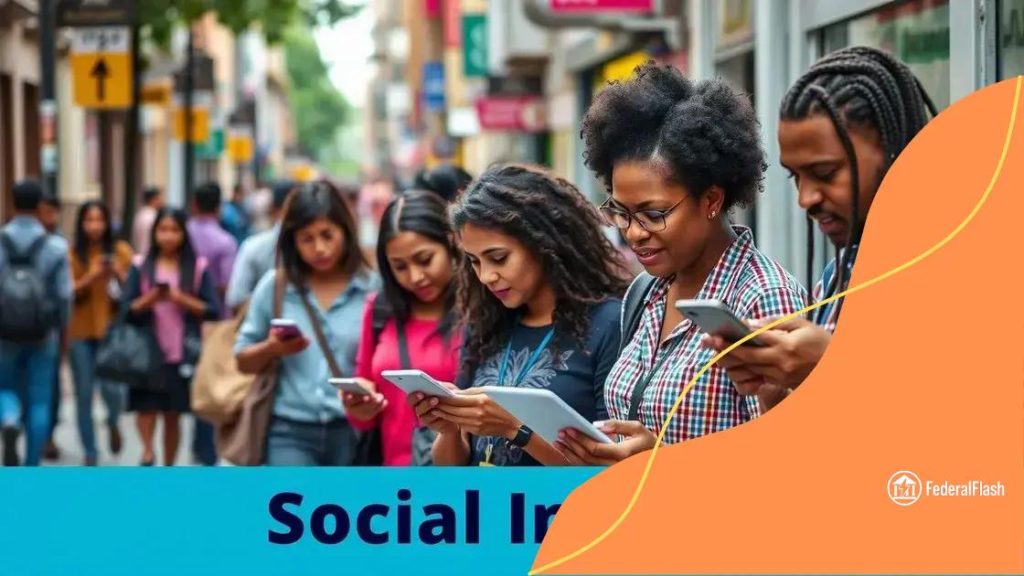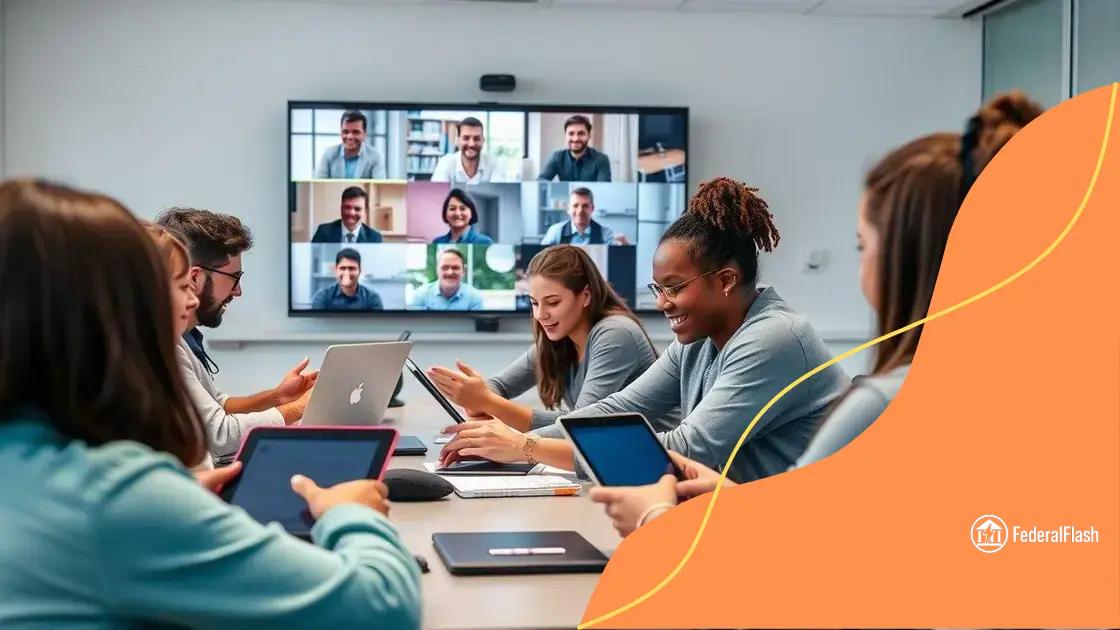New tech and social impact: How technology shapes our world

Anúncios
Emerging technology trends, such as artificial intelligence, virtual reality, and the Internet of Things, are reshaping industries by enhancing efficiency, transforming education, and influencing public opinion while highlighting the importance of data privacy.
New tech and social impact are closely intertwined, influencing everything from our daily interactions to global movements. Have you ever wondered how these technologies shape our communities and the world? Let’s dive into this fascinating topic.
Anúncios
Understanding the relationship between technology and society
Understanding the relationship between technology and society is essential in today’s fast-paced world. As innovations emerge rapidly, we must recognize their profound effects. Technology shapes our interactions, economies, and cultures.
How Technology Affects Daily Life
First, consider how the internet has transformed communication. People can connect instantly across the globe. This change has fostered relationships and created opportunities for learning.
- Instant messaging has replaced letters.
- Video calls allow for face-to-face interactions.
- Social media connects families and friends.
Moreover, technology influences our work environments. Remote work is now common, creating flexibility but also challenges. Business models have evolved, leading to new practices that benefit from technological advancements.
Anúncios
Economic Implications of Technology
The economy has also changed due to technological growth. Automation is increasing efficiency in various industries, but it raises concerns about job displacement. Understanding these challenges helps society adapt more effectively.
- New job opportunities emerge alongside automation.
- Learning new skills is essential for future job markets.
- Businesses must innovate to stay competitive.
As we engage with technology, we can also consider its social impacts. For instance, social media platforms have altered how we share news and express opinions. This influence shapes public discourse, in both positive and negative ways.
Fostering a responsible relationship between technology and society involves awareness. Recognizing both the benefits and risks can lead to informed choices. By understanding this dynamic, we contribute to a more thoughtful use of technological advancements.
Key examples of technology’s social impact
Key examples of technology’s social impact reveal how innovations reshape our lives. One notable area is education. Learning platforms have emerged, allowing access to education for millions. With online courses, students can learn from anywhere at any time.
Transformations in Education
This change in educational access promotes inclusivity. For instance, students in remote areas can now connect with expert educators without needing to travel. This technology also enhances learning experiences through interactive tools.
- Online resources provide diverse materials.
- Virtual classrooms encourage collaboration.
- Adaptive learning software caters to individual needs.
Another significant example is healthcare. Telemedicine has gained traction, especially during health crises. Patients can consult doctors remotely, improving access to care.
Healthcare Innovations
This shift reduces barriers, like distance and mobility issues. Additionally, wearable technology provides real-time health monitoring, empowering individuals to take charge of their well-being.
- Remote consultations increase patient convenience.
- Wearables track fitness and vital signs.
- E-health apps help manage chronic conditions.
Moving on to social media, this platform has changed how we communicate and engage with society. It has the power to mobilize communities around important issues and amplify voices that may be overlooked.
However, social media also presents challenges, such as misinformation and polarization. Recognizing both the advantages and the drawbacks is crucial in understanding its role in modern society. This dual nature of technology emphasizes the need for responsible usage and critical thinking as we navigate our connected world.
How new tech influences education and job markets

How new tech influences education and job markets is a vital topic today. The integration of technology into learning environments has transformed how students access information and skills. With online learning platforms, education is more inclusive and flexible than ever before.
Impact on Educational Methods
Modern technology allows for a variety of learning styles. Students can engage through videos, interactive content, and forums. These tools enhance the overall learning experience.
- Online courses provide flexibility for busy schedules.
- Virtual classrooms enable students to connect globally.
- Adaptive learning technologies cater to individual needs.
Moreover, educational technology fosters collaboration. Students can work together on projects using shared digital platforms, building teamwork skills that are essential for the modern workforce.
Shifts in Job Markets
In addition to impacting education, technology is reshaping job markets. Automation is changing roles in many industries. While it increases efficiency, it also creates a requirement for new skills.
- Jobs in traditional sectors may decline.
- New positions emerge in tech-driven fields.
- Continuous learning and upskilling are necessary for career growth.
Furthermore, technology enables remote work, making job opportunities accessible to a broader audience. This shift has implications for work-life balance and company culture. Employers increasingly value adaptability and tech-savviness in candidates.
As the landscape of education and employment evolves, embracing these changes can lead to innovative solutions. Adapting to new technologies helps prepare individuals for success in a rapidly changing world.
The role of social media in shaping public opinion
The role of social media in shaping public opinion is profound and constantly evolving. Platforms like Twitter, Facebook, and Instagram allow people to voice their thoughts instantaneously, meaning opinions can spread like wildfire.
Influence of Social Media on News Dissemination
Social media also revolutionizes how news is shared and consumed. Instead of relying solely on traditional news outlets, individuals often turn to their feeds for updates.
- Breaking news spreads quickly across platforms.
- Users can directly comment and engage with news stories.
- Community opinions can influence broader discussions.
This immediacy transforms the public’s perception of events. As information flows, it shapes narratives and influences how people view certain issues or events.
The Power of Virality
Additionally, content that goes viral can sway public opinion in unexpected ways. Memes or videos often catch attention and provoke discussion, highlighting social issues or cultural trends.
- Viral content can bring awareness to overlooked topics.
- Engaging formats make complex issues digestible.
- Influencers can amplify voices and perspectives.
While social media promotes diverse voices, it also leads to the spread of misinformation. False narratives can gain traction, challenging users’ ability to discern truth from deception. This dual nature calls for critical thinking and media literacy.
As people navigate the digital landscape, understanding the influence of social media on public opinion is essential. It requires staying informed and questioning the sources of information. Balancing engagement with skepticism helps individuals participate in discussions more thoughtfully.
Emerging trends in technology and their potential effects
Emerging trends in technology are shaping our future and how we interact with the world around us. From artificial intelligence to virtual reality, these trends have a significant impact on various sectors, including education, healthcare, and communication.
Artificial Intelligence and Automation
One of the most prominent trends is the rise of artificial intelligence (AI). AI is enhancing efficiency by automating routine tasks. This allows humans to focus on more complex responsibilities, opening new opportunities in the workforce.
- Chatbots improve customer service by handling inquiries.
- AI-driven analytics assist in decision-making.
- Automation reduces errors in manufacturing processes.
However, the increase in automation raises concerns about job displacement. It is crucial for workers to develop new skills to adapt to changing job markets.
Virtual and Augmented Reality
Another exciting trend is virtual reality (VR) and augmented reality (AR). These technologies are transforming experiences in various fields, like education and entertainment. VR can create immersive learning environments, while AR enhances real-world experiences with digital overlays.
- VR provides hands-on training in a safe environment.
- AR applications can assist with navigation in unfamiliar places.
- Both technologies foster creativity in storytelling.
As these technologies evolve, they also spark discussions about ethics and privacy. The ability to collect vast amounts of data raises questions regarding its use and security. Users must be aware and informed about how their information is handled.
Moreover, the adoption of the Internet of Things (IoT) is another significant shift. Everyday devices connect to the internet, allowing for smarter homes and cities. This connectivity fosters greater convenience but also highlights the importance of cybersecurity.
Remaining vigilant about these emerging trends in technology can help individuals and organizations embrace innovation while addressing potential challenges.
FAQ – Frequently Asked Questions about Emerging Technology Trends
What are some key emerging trends in technology?
Key emerging trends include artificial intelligence, virtual and augmented reality, and the Internet of Things (IoT), all of which are transforming various industries.
How does artificial intelligence impact the job market?
Artificial intelligence can automate routine tasks, leading to increased efficiency but also raising concerns about job displacement. It’s important for workers to upskill accordingly.
What role do virtual and augmented reality play in education?
VR and AR enhance learning by providing immersive experiences, making complex subjects more engaging and accessible to students.
Why is data privacy important in the context of emerging technologies?
As technology collects vast amounts of data, understanding data privacy helps users protect their personal information and ensures responsible use of their data.